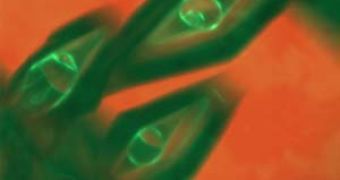Many organism, like fish, insects, frogs, plants, fungi and bacteria, resist through the winter freeze due to antifreeze or ice structuring proteins (ISPs) that bind to the surface of ice crystals to stop their growth and keep the organism alive.
Otherwise, the animals exposed to freezing temperatures would normally freeze full of jagged ice crystals.
But researchers have been puzzled about why some ISPs, like those of the spruce budworm, from US and Canada, are more effective than others.
Now a team led by Ido Braslavsky, an assistant professor of physics and astronomy at Ohio University Fluorescence and Peter Davies, a professor of biochemistry and biology at Queen's University in Canada employed fluorescent microscopy to understand this.
The team combined spruce budworm and fish ISPs with a fluorescent tag and under the fluorescent microscope the researchers were able to watch how the proteins interacted with the surfaces of ice crystals. They soaked small ice crystals in a solution with tagged ISPs. They watched the proteins swarming ice crystals and stunting their growth.
As they lowered the temperature, the ISP-covered particles kept the same size until rapidly expanding into larger crystals when the temperature dropped too much for the protein to work anymore. Ice particles bound together in sheets that resemble honeycombs.
They discovered that the hyperactive ISP from the spruce budworm impeded ice crystals from growing in particular directions; ice could only attach to the top or bottom of these sheets.
The budworm protein were collected on both the corners and the flat surfaces of the ice crystals, forming an obstacle in both directions in which ice normally grows. The less effective ISPs from fish prevent these particles from expanding sideways, by binding to the edges of the crystal sheets.
Antifreeze proteins, especially the hyperactive type found in the spruce budworm and other organisms, have various potential applications, according to Braslavsky. This research could help in designing molecules that keep organs alive longer, crucial in preserving organs and tissues for transplants, and prevent frostbite. They could also inhibit crystal growth in low-fat ice cream (this is already employed by at least one commercial food manufacturer).
The team still wants to create and have a very clear picture on how individual ISP molecules stick to ice. "It's still not clear how they work exactly," said Braslavsky.

 14 DAY TRIAL //
14 DAY TRIAL //